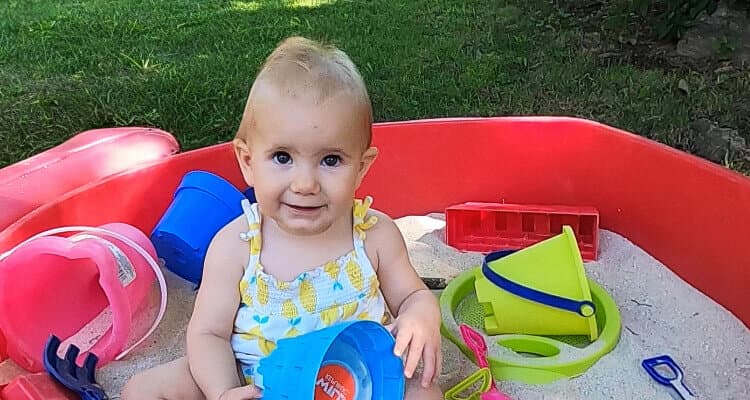

Children treated before
showing SMA symptoms (presymptomatic)
Treated at 1½ months old
Children treated before showing SMA symptoms (presymptomatic)
ZOLGENSMA® (onasemnogene abeparvovec-xioi) has been clinically proven to stop the progression of spinal muscular atrophy (SMA) and stop motor neuron loss with just one dose.
ZOLGENSMA was studied in children who were not showing symptoms (presymptomatic) of SMA in a trial called SPR1NT. The trial studied the safety and efficacy of ZOLGENSMA in children with 2 and 3 copies of the SMN2 backup gene. The main goal of this study was to see the number of children who could sit for 30 seconds or more (for children with 2 copies) and stand without support for 3 seconds or more (for children with 3 copies). The SPR1NT study also looked at how well children could perform specific motor skills, maintain weight without feeding support, and breathe on their own (respiratory status).
Children with 2 copies of SMN2 gene
Who was Studied
14 children with 2 copies of the SMN2 backup gene and no known symptoms of SMA participated in the study. All were under 6 weeks old—their average age was 20.6 days.
This study followed children up to 18 months of age.
What Were the Goals of the Study?
The main goal for this study was to look at the ability of children to sit independently (functional, independent sitting) for ≥30 seconds (Bayley-III* item 26) before they were 18 months old.
The SPR1NT study also evaluated event-free† survival in children at 14 months of age, as well as the ability to maintain their weight at or above the 3rd percentile without nutritional support before they were 18 months old. This is based on WHO Child Growth Standards.‡
*Bayley Scales of Infant and Toddler Development, 3rd edition (Bayley-III).
†Without the need for permanent ventilation support consisting of ≥16 hours of respiratory assistance per day continuously for ≥14 days.
‡The World Health Organization (WHO) created the WHO Child Growth Standards to chart physical growth.
Results
Children achieved and maintained the motor milestones assessed in the presymptomatic SPR1NT study
Sit Independently
100%
(14/14) of children with 2 copies of SMN2 could sit independently
(30 seconds or more) as measured by Bayley-III
In the natural history (untreated) of SMA Type 1, children are not able to sit.
11/14 children who achieved sitting independently did so within the normal development window for this milestone according to WHO-MGRS. The normal window of achievement for sitting without support is between 4 and 9 months of age (WHO-MGRS).§
§The World Health Organization Multicentre Growth Reference Study (WHO-MGRS) is a standardized timeline for motor development in unaffected children.
Children reached age-appropriate milestones.
Typically, clinical studies use standardized measurement scales to assess the progress and achievements of participants. In the SPR1NT study, the Bayley-III was used to determine children’s motor skills compared to what is expected for a typical developing child. The WHO-MGRS (World Health Organization Multicentre Growth Reference Study) was used to provide a timeline for motor milestone development in unaffected children.
Stand Without Assistance
71%
(10/14) of children stood without assistance (10 seconds or more) as measured by WHO-MGRS
5/10 did so within an age-appropriate time.
Walk Without Assistance
71%
(10/14) of children walked without assistance (5 steps or more) as measured by WHO-MGRS
6/10 did so within an age-appropriate time.

CHOP INTEND|| Score
100%
(14/14) of children reached a CHOP INTEND|| score of 58 or higher at any visit up to 18 months of age and 93% (13/14) achieved a score of 60 points or higher
||Children had improvement in motor function as assessed by CHOP INTEND, or the Children’s Hospital of Philadelphia Infant Test of Neuromuscular Disorders. This test was created to measure the motor development of children with SMA Type 1. The CHOP INTEND scale ranges from 0 to 64, with higher scores indicating better function.

Gross Motor Skills¶
64%
(9/14) of children had gross motor skills similar to same-aged children without SMA at the end of the study
¶Movement of large muscles in arms, legs, and torso.
Gross motor function was measured by the Bayley Scales of Infant and Toddler Development, a well-accepted, standardized tool to assess the development of children between the ages of 1 and 42 months and compared to a standardized norm. Part of this tool looks at the ability to make large muscle movements, like moving from one place to another.

Fine Motor Skills
100%
(14/14) of children had fine motor skills similar to same-aged children without SMA at the end of the study
Bayley-III Fine Motor Scores were used to determine children’s fine motor skills compared to what is expected for a typical developing child. This tool looks at the ability to make small muscle movements, like grasping and holding objects.

Survival/Breathe Without Support
100%
(14/14) of children were alive and free of permanent ventilation
Permanent ventilation means a tracheostomy or the need for a machine to help with breathing for at least 16 hours a day for 2 weeks or more.

Maintain Weight
93%
(13/14) of children in the 2-copy group maintained a normal weight (≥3rd percentile for age and gender)
This study determined whether children were able to maintain weight within a normal range (at or above the 3rd percentile for age and gender as defined by WHO guidelines) without the need for non-oral/mechanical feeding support at any visit up to 18 months of age (which was the end of the study).